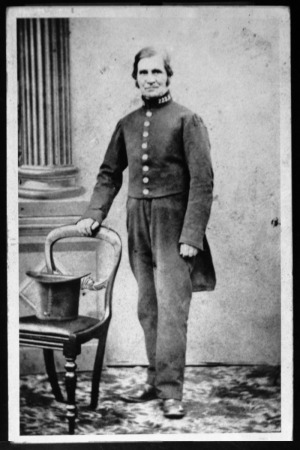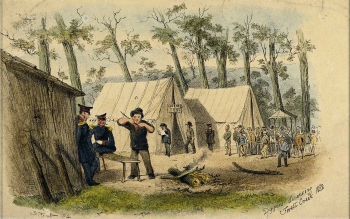This post was inspired by an inquiry from a Year 9 student. Thank you Arron.
The origins of public policing
Propelled by the discovery of gold, the nature of policing in Victoria changed dramatically during the 1850s. These changes aimed to develop a united professional police force, based on a model of civil policing introduced in London by Sir Robert Peel in 1829.
The introduction of Peel’s model of civil policing is now seen as a great leap forward in law and order. At the time, Peel’s model was controversial because it took the responsibility of policing away from local control and placed it in the hands of the government. The British public feared a police force used by the government to keep itself in power.
To help people accept this new form of policing, Peel’s model had several developments. These included police having no weapons except a concealed club and a rattle to attract attention; trying not to accept men of military rank or influence within the Government; and applying methods of crime prevention, rather than punishment. Police were assigned to a particular district, which was then divided into beats. A policeman would get to know his beat, and this would help him detect crime. Regulations and manuals regarding civil policing duties were also published. The distinctive police uniform functioned to make people aware of the police presence and minimise accusations of police acting as spies. Police were also ordered to be civil towards all members of the public. This civility extended to the point of accepting ridicule without any argument. You can read more about the development of Peel’s police here.
Policing in Victoria before Gold Discoveries
Policing in Victoria was a fusion of Peel’s London ideals and Australian circumstances. A lack of gentry in the Port Phillip District encouraged the growth of paid Police Magistrates. It was a system in which police acted as both judge and ‘thief-catcher’, and were subject to the direct control of the government.
Commissions, such as the Goldfields Commission represented another type of governing body that had police carrying out particular regulations and laws. Magistrates and Commissions rarely communicated with each other or co-ordinated policing activities. With numerous police-magistrates and various commissions, the control of the police was not under a centralised authority pre- 1852.
Gold Rush Policing
Native Police Corps
At the beginning of the gold rushes in Victoria, there was a call from some of the successful diggers for police to escort them and their gold to the safety of Melbourne. They first appealed to Captain Dana, commander of the Native Police Corps but he declined. The diggers then asked the Governor of Victoria, Charles Joseph Latrobe, arguing that licence fees should provide them with Government protection. The Native Police Corps was the only effective policing unit left to Latrobe, as most of the European police had left their posts to head for the goldfields. This led to the Native Police being the first police on the goldfields, a role they maintained for about the next two years.
Recruiting troubles
There were not enough Native Police to cope with the growing needs of goldfields policing, so efforts were made to recruit more police to fill this need. Policing was not considered to be a full-time professional career. In 1852 the wages were 5 shillings and 5 pence a day. Police could increase their wages through incentive payments which involved catching people for fine-able offences. These included prosecutions for mining without a licence, obscene language and selling liquor without a licence. A combination of the poor pay, the minimal qualifications needed and these ‘incentive payments’ led to many of the wrong type of people becoming police. Since the convict settlement in New South Wales, the military had played a significant role in policing the community. It was not unusual to find many police-magistrates and policemen with military backgrounds. This was exactly the opposite of Peel’s model of policing. Ex-convicts were among the various members of the police forces, and this caused some concerns.
1853-55 Combining and Reforming
One of the recommendations made by an 1852 Committee inquiry was the formation of a united police force. The formation of the Victoria Police Force was made 1 January 1853 and the administration was based on Peel’s model.
This meant that the various different police bodies were disbanded and formed into one unified body, with three main branches and nine districts. Each district was commanded by an Inspector, who reported directly to the Chief Commissioner. Pay was increased to ten shillings a day to encourage the right sort of men to apply. Along with this, fifty police were selected from London to work with the Victorian police.
While the administration for a united police force was put into place, several features of the force remained the same. There was no uniform to indicate that the Victoria Police Force was a unified body, there were no regulations or guidelines, and the system of administration on the goldfields remained almost the same as before reformation. While the officer attached to each gold district was in charge of police discipline, the Resident Commissioner of the Goldfields determined how the police were to be employed. The quality of the goldfields police and the incentives for them to hunt for diggers without licences were sources of frustration to diggers. These problems, combined with corruption within the Goldfields Commission were major factors that led to the Eureka Stockade in December 1854.
1855 onwards
The 1855 Royal Commission on the goldfields recommended the abolition of the Goldfields Commission and the miner’s license fee. This meant that police on the goldfields now had a single command, were able to focus more on the prevention of crime, and one of the major causes of friction between miners and police, (the license fee) was removed.
There was also another Royal Commission into the police in 1855. This inquiry asserted the need to remove the military style of policing. This in turn led to the creation of a police manual which was published in 1856. The uniform of the Victoria Police Force was introduced in 1855 and was in full circulation by 1856.
There was still one major difference between Victorian police and their London counterparts. In Victoria, police carried firearms.
If you want to learn more about the history of Victoria Police, visit their Museum website, or download a timeline of the Victoria Police. There is also a great pictorial timeline of the changing uniforms provided online by the Herald Sun.
Want to see a trooper fire his gun? click below.













who was the author
One of our teacher-qualified Education Officers 🙂
Why was life on the goldfields as a policeman dangerous?
Hi Harper. Thanks for the question 🙂 It could be dangerous to work for the police force on the goldfields because you were likely to be unpopular among the large community of miners. The troopers/traps as they were known on the diggings were responsible for checking the Gold Licences of the miners, and often abused their power by stealing licences (because they took home half of the fine the miner had to pay for being caught without one) and even had a reputation for beating people up for fun! This is part of the reason the government had trouble finding people to do this job, and often the only people desperate enough to take it up were ex-convicts from Sydney and Hobart. Turning crims into cops was not a great way of maintaining law and order on the diggings!
Thank you for this helpful website!
I loved reading this text
Thank you for the help! It was a very good source of information. I cannot wait to go to sovereign hill soon.